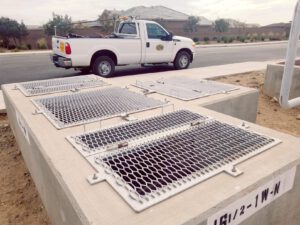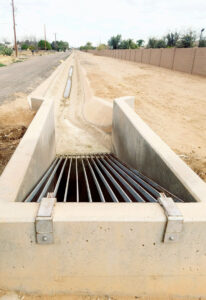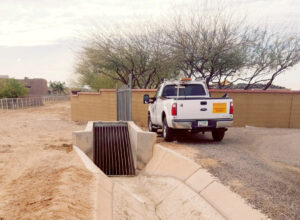Roosevelt Water Conservation District (RWCD) serves a growing customer base in and around the cities of Mesa and Chandler and the town of Gilbert in central Arizona. Urbanization and a more active population have the potential to create public safety issues in and around RWCD’s canals. In central Arizona, the public perception is that canals are the closest things we have to rivers and the activities rivers would provide for under normal circumstances. People want to walk their dog along the edge, sit on the bank to reflect on the workday, or fish in the canal, but these are the very activities that pose a tremendous safety risk. A canal system is not conducive to both public entertainment and public safety as a matter of routine design. As an organization, RWCD knows that it would be next to impossible to construct a barrier around our entire system to keep trespassers out. As such, RWCD’s public safety plan is multifaceted and constantly evolving.
 The canal is doing what it is supposed to do, and it is not until the human element is introduced that it can become dangerous. Transportation engineers design streets and sidewalks for the movement of people and take safety precautions into consideration as a normal course of design. Canals and irrigation infrastructure are designed to move water, so the safety of the public is not a typical consideration.
The canal is doing what it is supposed to do, and it is not until the human element is introduced that it can become dangerous. Transportation engineers design streets and sidewalks for the movement of people and take safety precautions into consideration as a normal course of design. Canals and irrigation infrastructure are designed to move water, so the safety of the public is not a typical consideration.
RWCD’s system operates 24 hours a day, 7 days a week, 365 days a year, so we always have personnel in the field. However, the primary purpose of our personnel, as with the delivery system, is the safe and timely delivery of water. Public safety concerns are important to us, but it is difficult to address such matters given the large number of acres and miles of system we operate compared to the number of staff we have in the field at any given time. And when an emergency does occur, our employees are often not in the area
RWCD delivers water to farms, ranches, subdivisions, schools, and businesses across 40,000 acres. Given the size of the district and the overlapping service jurisdictions we have with local municipalities, the appropriate law enforcement authority could be one of four policing agencies. As such, it can be confusing for our employees, the public, and even law enforcement at times to determine which is the appropriate agency to contact during an emergency.
When we do contact the police, we have to see where we rank in relation to the local day’s activities: automobile accidents, armed robberies, and any number other serious issues may be occurring at the same time. When an irrigation district calls to say it has a trespasser on or near the canal, it may not necessarily be a priority for local law enforcement at the time.
 For example, during our last dry-up period, we had a substantial capital project being constructed in and around our main canal. During the course of construction, we doubled up on our posting of no trespassing signs, including erecting traffic barricades at either end of the project. Nevertheless, when our contractor returned to the site one morning, they found a man in Bermuda shorts and flip flops standing on the top of newly placed 42-inch RGRCP pipe section, in a 50-foot wide by 100-foot long by 20-foot deep construction and excavation pit. He absolutely would not leave the area, insisting that he was a taxpayer and an engineer and had every right to be on the site to investigate. We hated to do it, but we had to call the police. Thankfully, this was an isolated incident, but it does serve to illustrate the attitude of certain members of the public when it comes to canals and irrigation rights-of-way.
For example, during our last dry-up period, we had a substantial capital project being constructed in and around our main canal. During the course of construction, we doubled up on our posting of no trespassing signs, including erecting traffic barricades at either end of the project. Nevertheless, when our contractor returned to the site one morning, they found a man in Bermuda shorts and flip flops standing on the top of newly placed 42-inch RGRCP pipe section, in a 50-foot wide by 100-foot long by 20-foot deep construction and excavation pit. He absolutely would not leave the area, insisting that he was a taxpayer and an engineer and had every right to be on the site to investigate. We hated to do it, but we had to call the police. Thankfully, this was an isolated incident, but it does serve to illustrate the attitude of certain members of the public when it comes to canals and irrigation rights-of-way.
In the mid-2000s, RWCD used a pilot program that installed several cameras along our canal systems and other property to monitor activity. Within a span of 30–45 days, each of those cameras had been stolen or incapacitated. More recently, we placed a camera in the public view atop a 20-foot pole. Although we could see when, where, and what people were doing, the benefits were short lived, as that camera was stolen as well. Finally, in cases where we might have been able to catch someone committing a crime in real-time on the camera, the person would be long gone by the time anyone could respond.
If the public wants to get into RWCD’s irrigation system and property badly enough, they will find a way. It is simply a fact. Until we are able to adopt a plan to keep members of the public out completely or safely invite them onto the premises, we are investing in infrastructure to prevent potential accidents and deaths from drowning. RWCD has implemented rope systems at different points along our largest canal. The systems are adjustable based on water flow, so if someone gets in, they have the ability to grab on to the rope, move themselves across to a ladder, and get out of the canal.
In addition to this capital investment, we have also created two new positions within the last couple years— neighborhood liaison and media and public outreach coordinator—to focus on increasing public knowledge of our system and facilitate community partnerships. Our neighborhood liaison works directly with our small lot and subdivision customers to provide them with a better understanding of both the private and the district irrigation systems.
Our media and public outreach coordinator handles our social media accounts and works with other groups in our community to educate the public about who we are and the stewardship we provide regarding water in central Arizona. We plan to rely heavily on social media to spread the news that our system is not accessible to the public.
We are also looking for opportunities to work with our local municipalities to address trespassing in a more direct manner when possible—in essence, taking advantage of opportunities to work with local organizations to educate the public with a consistent message about canal safety. For example, RWCD has been partnering with our local airport to suggest good places from which to watch its yearly airshow and places to avoid, such as the banks of our main canal. We are also engaging the public on social media to communicate what is and what is not open to the public during these types of events.
I encourage our team to make each interaction with the public a constructive one. I know it is not productive for our employees, the district, or the public to have negative interactions with each other. So, in addition to informing people that it is illegal and dangerous to be on the canal, we try to point them in a positive direction.
For example, we recently had teenagers fishing in the canal. Considering everything else teenagers could be doing in today’s day and age, I believe fishing is a positive activity. Instead of just lecturing them, we pointed them to a nearby place where it is legal to fish, so they could catch bigger and better fish in a lawful manner.
Overall, public safety for RWCD is constantly evolving. What might have worked a year ago might not necessarily work today. However, we try to stay ahead of what people may do, mitigate the negative effects should an accident occur, and continue to provide knowledge to the community.
Public safety has become a real issue for conservation districts, and it is worth spending time to plan and reassess when necessary. Preparing for the human element, both invited and not, is imperative in canal maintenance and operations.
Shane M. Leonard is the general manager of the Roosevelt Water Conservation District. He is the fourth generation of his family to work for the district. For more information about RWCD’s public safety program or its media and outreach program, you can reach Mr. Leonard at s.leonard@rwcd.net.

